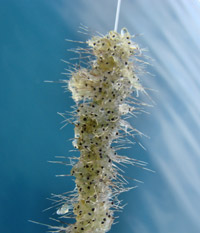The fishhook waterflea was discovered near Valcour Island in September, making it the fifty-first known invasive species to date in Lake Champlain. The discovery was made by Plattsburgh SUNY’s Lake Champlain Research Institute (LCRI) at an established Lake Champlain Long-term Biological Monitoring Program site supported by the Lake Champlain Basin Program. Analysis of the water samples by LCRI’s Dr. Tim Mihuc and his staff confirmed high densities of over 100 individual fishhook waterfleas per sample. “This invasion represents a major change in the Lake Champlain food web” noted Dr. Mihuc. “Fishhook waterflea is a voracious predator that will eat native plankton species as its main food source.”
The fishhook waterflea is about one centimeter long, including its distinctive “fish hook”, a long spiny tail with a loop at the end. The tails can tangle in fishing lines and with one another, bringing fleas together into clumps that look and feel like wet cotton. Fishhook waterfleas can have a negative impact on biodiversity, should their populations grow large enough to cause a decline of native zooplankton species that they prey upon. This decline would in turn impact the small (or juvenile) fish that feed on zooplankton, and the larger fish that feed on these smaller species.
Fishhook waterfleas can reproduce several times in a season. In addition to sexual reproduction, the females of the species are able to reproduce parthenogenically, which is a form of asexual reproduction where they grow clones of themselves in brood sacs. In the fall the fishhook waterflea lays resting eggs in the lake sediment, which are able to overwinter our region’s low temperatures in order to hatch the next summer. Population densities are therefore highest late in the season, so it’s not a surprise that the fishhook waterflea was not detected in earlier samples taken in June.
The fishhook waterflea is similar in many ways to the spiny waterflea, another invasive zooplankton that was discovered in the lake in 2014 (<link learn news item spiny-water-flea-have-arrived-what-next _blank>Click here to read LCC’s 2014 article about that discovery). Both are known to foul fishing lines and nets, and both prey on native zooplankton.
Native to Eurasia, this invasive waterflea came to the United States in the 1980s, where it was carried into the Great Lakes region in ballast water. Before its discovery in Lake Champlain, the closest known populations were in Lake Ontario and the New York Finger Lakes. It was likely transported from there in a boat or on recreational equipment.
Spread Prevention
Fishhook waterflea, like many aquatic invasive species, are invisible to the naked eye at certain life stages. It’s imperative to be aware of their presence in a waterway, and be diligent about preventing their spread. Follow these tips to avoid transporting them:
- Clean all plants, plant fragments, animals, and mud from boating and recreational equipment.
- Check and clean anchor lines.
- Drain water from all compartments including the bilge, live wells, bait buckets, and storage compartments before leaving a water body.
- Dry all surfaces of your boat, trailer, and all other equipment that has touched the water. It is strongly recommended that these surfaces are dried with a towel, then allowed to stand in the sun for five to seven days, before introducing them to a new water body.
- Inspect all gear including paddles, spray skirts, bilge pumps, fishing rods, spools of fishing line, nets, and downrigger cables and remove any debris.
- Change fishing line and tackle when moving from one water body to another.
The Lake Champlain Basin Aquatic Invasive Species Rapid Response Task Force, which LCC helped form, is currently assessing the potential impacts of the fishhook waterflea and evaluating management options. There are no known control technologies to eliminate either the fishhook or spiny waterflea once they are established in a water body. Efforts will focus on preventing the spread of this species to other bodies of water in the region.
